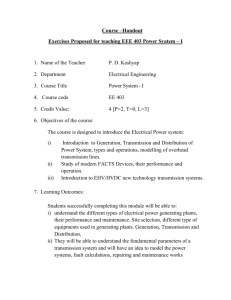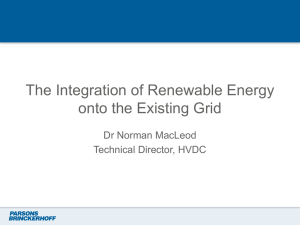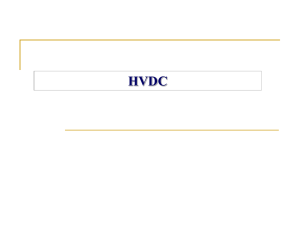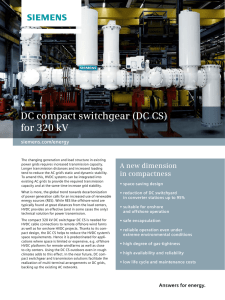Fault Analysis and HVDC Power Transmission Turbine Grid System
advertisement
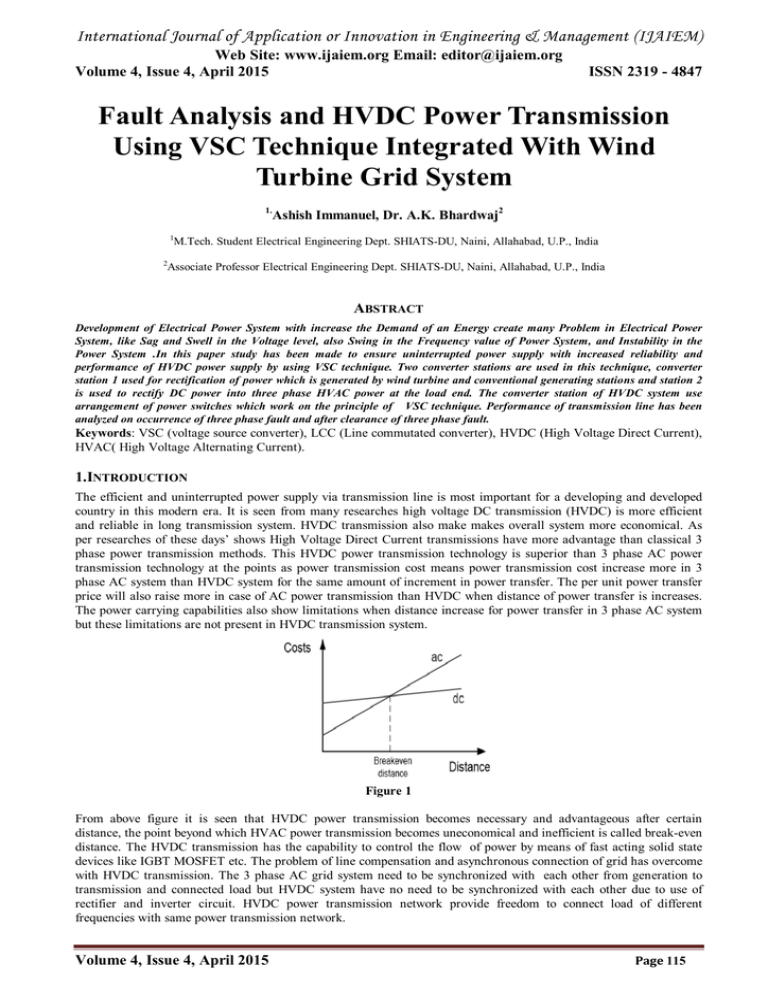
International Journal of Application or Innovation in Engineering & Management (IJAIEM) Web Site: www.ijaiem.org Email: editor@ijaiem.org Volume 4, Issue 4, April 2015 ISSN 2319 - 4847 Fault Analysis and HVDC Power Transmission Using VSC Technique Integrated With Wind Turbine Grid System 1. Ashish Immanuel, Dr. A.K. Bhardwaj2 1 M.Tech. Student Electrical Engineering Dept. SHIATS-DU, Naini, Allahabad, U.P., India 2 Associate Professor Electrical Engineering Dept. SHIATS-DU, Naini, Allahabad, U.P., India ABSTRACT Development of Electrical Power System with increase the Demand of an Energy create many Problem in Electrical Power System, like Sag and Swell in the Voltage level, also Swing in the Frequency value of Power System, and Instability in the Power System .In this paper study has been made to ensure uninterrupted power supply with increased reliability and performance of HVDC power supply by using VSC technique. Two converter stations are used in this technique, converter station 1 used for rectification of power which is generated by wind turbine and conventional generating stations and station 2 is used to rectify DC power into three phase HVAC power at the load end. The converter station of HVDC system use arrangement of power switches which work on the principle of VSC technique. Performance of transmission line has been analyzed on occurrence of three phase fault and after clearance of three phase fault. Keywords: VSC (voltage source converter), LCC (Line commutated converter), HVDC (High Voltage Direct Current), HVAC( High Voltage Alternating Current). 1.INTRODUCTION The efficient and uninterrupted power supply via transmission line is most important for a developing and developed country in this modern era. It is seen from many researches high voltage DC transmission (HVDC) is more efficient and reliable in long transmission system. HVDC transmission also make makes overall system more economical. As per researches of these days’ shows High Voltage Direct Current transmissions have more advantage than classical 3 phase power transmission methods. This HVDC power transmission technology is superior than 3 phase AC power transmission technology at the points as power transmission cost means power transmission cost increase more in 3 phase AC system than HVDC system for the same amount of increment in power transfer. The per unit power transfer price will also raise more in case of AC power transmission than HVDC when distance of power transfer is increases. The power carrying capabilities also show limitations when distance increase for power transfer in 3 phase AC system but these limitations are not present in HVDC transmission system. Figure 1 From above figure it is seen that HVDC power transmission becomes necessary and advantageous after certain distance, the point beyond which HVAC power transmission becomes uneconomical and inefficient is called break-even distance. The HVDC transmission has the capability to control the flow of power by means of fast acting solid state devices like IGBT MOSFET etc. The problem of line compensation and asynchronous connection of grid has overcome with HVDC transmission. The 3 phase AC grid system need to be synchronized with each other from generation to transmission and connected load but HVDC system have no need to be synchronized with each other due to use of rectifier and inverter circuit. HVDC power transmission network provide freedom to connect load of different frequencies with same power transmission network. Volume 4, Issue 4, April 2015 Page 115 International Journal of Application or Innovation in Engineering & Management (IJAIEM) Web Site: www.ijaiem.org Email: editor@ijaiem.org Volume 4, Issue 4, April 2015 ISSN 2319 - 4847 HVDC power transmission can be done with two techniques i.e. Line commutated Converter (LCC) technique and Voltage Source Converter (VSC) technique. 2. COMPARISON BETWEEN VSC-HVDC AND LCC-HVDC POWER TRANSMISSION Line commutated converter (LCC) HVDC can be type of a Current Sourced Converter or Thyristor based Technology, while Self Commutated Converter and Transistor (IGBT,GTO etc.) based Technology are the type of Voltage Source converter. Line commutated converter also known as LCC technique which have dependency upon polarity appearance across the power switches of converter but Voltage source converter (commonly known as VSC) technique do not such dependency. VSC-HVDC system needs auxiliary circuitry to control the power flow, thus this system have better power flow controlling capability. The LCC-HVDC is line commutated means switching action takes place at supply frequency i.e.at 50 or 60 Hz, while VSC-HVDC systems have switching frequencies of 1-2 kHz. Therefore, the necessary filter size is reduced; and therefore cost is reduced. LCC-HVDC converters can control reactive power only and controlling depends on the firing angle of thyristors and various FACTS devices like STATCOMs.VSC-HVDC systems can control the active and reactive power at both ends and it can help to control the grid’s voltage and enhance power quality. Figure.2Typical layout of VSC-HVDC transmission The reactive power is responsible to control the voltage of the system and by controlling the active power frequency of the system can be controlled in VSC-HVDC system, but in case of LCC-HVDC system frequency control does not possible. 3.MATHEMATICAL MODELLING To generate proper signal for controlling the switching action perform by power switches is main concern of sending end converter station. These station are use to convert 3 phase current convert into Direct current and feed to HVDC buss bar system. Generation of switching signals for power switches is based on values of direct current and quadeture current which obtain by planks 3 to 2 conversion transformation technique. These direct value of line current and quadeture value of line current are compare with preset values of Id and Iq in comparator circuit to generate error signal these error signals are fed to the PI controller. Selection of PI controller is done on the basis of need to reduce the value of steady state error as well as reduction of peak over shoot values of the output of HVDC sending end station due to HVDC transmission system have certain magnitude based limitation over DC power transmission capabilities. With the help inner current controller and outer current controller the DC link voltage, active and reactive power can be controlled by VSC-HVDC system. The inner current controller (ICC) transforms the converter current and the AC three phase voltages into the rotating direct-quadrature (d-q) co-ordinate system. The outer controllers are used to generate and to provide reference currents (iq & id) to ICC. Volume 4, Issue 4, April 2015 Page 116 International Journal of Application or Innovation in Engineering & Management (IJAIEM) Web Site: www.ijaiem.org Email: editor@ijaiem.org Volume 4, Issue 4, April 2015 ISSN 2319 - 4847 Figure 3 inner current controllers Figure 4 Active and Reactive power outer current controller The schematic diagram and the vector-based equivalent circuit of a VSC station in the synchronous dq reference frame is shown in Fig.4. Figure. 5 Schematic diagram and equivalent circuit of a VSC station Vc=Vs-RcIc-jωLcIc-Lcdi/dt Ic=Is-jωsωfVs-CfdVs/dt CdcVdc/dt=Idc-IL Ps+jQs=3/2VsIs Pdc=Ps - IcRc =VdcIdc CfdVs/dts=Is-Ic-jωCfVs Rc=total loss of vsc, Lc=filter inductor,Cf=filter capacitor 4.RESULT AND DISCUSSION The figure 6 represents sending end voltage waveform when fault is not occurred. From this figure we see that the voltage waveform is mostly pure sine-wave. The power, which is to be transmitted over the transmission line, is generated by conventional generating station. The conventional generating station is also integrated with wind turbine system. The integration of wind generation and conventional power generation makes the system reliable and ensures the uninterrupted power supply to the consumer end. Since the wind flow does not constant during the whole day, hence to synchronize the two types of generating plant converter stations are used. These converter stations, consists of rectifier station i.e. converter station 1 and inverter station i.e. converter station 2, used to transmit the high voltage direct current (HVDC) power along with voltage source converters . Volume 4, Issue 4, April 2015 Page 117 International Journal of Application or Innovation in Engineering & Management (IJAIEM) Web Site: www.ijaiem.org Email: editor@ijaiem.org Volume 4, Issue 4, April 2015 ISSN 2319 - 4847 Figure 6 Sending end voltage waveform Figure 7 represents the load end voltage waveform during the three phase condition. During three phase fault condition the waveform is disturbed. Because of disturbed waveform voltage sag or swell occurs at load end which affects performance of numerous equipments and finally get damaged if fault sustains for more time. Figure 7 Load end voltage waveform during fault. The figure 8 shows the load end waveform after the clearance of fault, the harmonics content in the waveform is almost removed and total harmonic distortion (THD) minimised. The THD is 88.7% without wind turbine and it gets reduced 21.3% with wind generation. Hence wind generation not only provides uninterrupted power supply but it improves power quality also. Figure 8 Load end voltage waveform after fault clearance. Figure 9 shows the successful DC power transmission between two converter stations. To control the flow of DC power after station 1 and ac power after station 2 voltage source converters are used. The VSC-HVDC system enable to use of multi-terminal system. Figure 9 DC voltage transmitted between station-1 and station-2 5. CONCLUSION Simulation results show that HVDC power successfully transmitted and can be controlled with help of voltage source converter (VSC). After the clearance of three phase fault, the voltage profile as well as power quality is improved. The integration of wind turbine enhances the system reliability and it also serves as peak load plant. Volume 4, Issue 4, April 2015 Page 118 International Journal of Application or Innovation in Engineering & Management (IJAIEM) Web Site: www.ijaiem.org Email: editor@ijaiem.org Volume 4, Issue 4, April 2015 ISSN 2319 - 4847 References [1] Yuan Fu1,a, Yi Wang1,b, Yingli Luo,c, and Xiangyu Zhang,c, “Operation and Coordinated Control of Multiterminal VSC-HVDC Transmission System for Wind Power Generation”,in International Conference on Power and Energy Systems Lecture Notes in Information Technology, [2] N. Ahmed, A. Haider, D. Van Hertem, Z. Lidong, and H. P. Nee, "Prospects and challenges of future HVDC SuperGrids with modular multilevel converters," in Power Electronics and Applications (EPE 2011), 2011, pp. . [3] D. Van Hertem and M. Ghandhari, "Multi-terminal VSC HVDC for the European supergrid: Obstacles," Renewable and Sustainable Energy Reviews, vol. 14, pp. 3156-3163, 2010. [4] L. Xu, L.Yao, Bazargan, M., “DC grid management of a multi-terminal HVDC transmission system for large offshore wind farms.” Proc. First SUPERGEN Conf., Nanjing, China, April 2009. [5] Temesgen M. Haileselassie, Marta Molinas. Tore Undeland, “Multi-Terminal VSC-HVDC System for Integration of Offshore Wind Farms and Green Electrification of Platforms in the North Sea,” Proc. Nordic Workshop on Power and Industrial Electronics, June, 2008. [6] L. Xu, L.Yao, Bazargan, M., Williams, B.W., “Control and operation of multi-terminal dc systems for integrating large offshore wind farms.” Proc. Seventh Int. Workshop on Large-Scale Integration of Wind Power and Transmission Networks for Offshore Wind Farms, Spain, May 2008. [7] Chen Z.," Compensation schemes for a SCR converter in variable speed wind power systems", Power Delivery, vol. 19, pp. 813-821,2004. [8] Bozhko S., Asher G., and Risheng L.," Large Offshore DFIG-Based Wind Farm With Line-Commutated HVDC Connection to the Main Grid: Engineering Studies", Energy Conversion, vol. 23, pp. 119-127,2008. [9] H. Chong A.Q., Huang and M.E. Baran," STATCOM Impact Study on the Integration of a Large Wind Farm into a Weak Loop Power System", Energy Conversion, vol. 23, pp. 226-233,2008. [10] Dawei X., Li R., and Bumby J.R.," coordinated control of an HVDC link and doubly fed induction generators in a large offshore wind farm", Power Delivery, vol. 21, pp. 463-471,2006. [11] Tomasz Drobik,” High-voltage direct current transmission lines” IEEE Conference Publishing.2006 Volume 4, Issue 4, April 2015 Page 119
